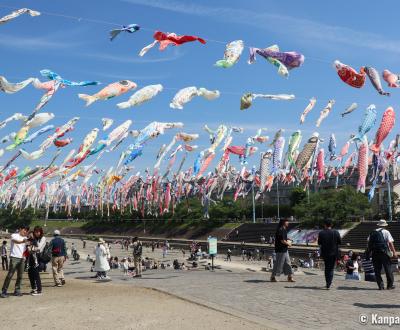Kodomo no Hi
🎏 Koinobori and Boys' Day in Japan
Kodomo no Hi, literally "children’s day", is a Japanese holiday taking place on May 5 at the end of the Golden Week, the national vacation week. This celebration, held in the family circle, originated from China and after many evolutions, is now dedicated to children, especially boys. The koinobori flag carp is one of its iconic symbols as well as the miniature samurai’s armor and helmet decorating the houses.
May 5 or Kodomo no hi, is one of the five sekku (節句) celebrations, that indicate the passing of seasons, with:
- January 1 (New Year),
- March 3 (Hina Matsuri, the dolls’ festival or girls’ day),
- July 7 (Tanabata, the star festival); and,
- September 9 (Kiku no sekku, chrysanthemums’ day).
This celebration originates from China and is widespread in Asia. In Japan, it was called tango no sekku (端午の節句) until 1948, when it became a holiday and was renamed Kodomo no hi. Tango meant "first day of the fifth month" in the former Chinese lunar calendar. The fifth month of the year was considered unlucky, but it was also the rice seedlings planting period, an important task that was traditionally performed by women.
Rituals involving odoriferous plants such as sweet flags, a kind of marsh herb whose Japanese name is shobu (菖蒲), were performed to protect the community, and especially women, from misfortune. Thus, on the first day of the fifth month, women were gathered and cloistered in a house whose roof was swept with sweet flags. Tango no sekku was originally a celebration to protect women.
The importance of the sweet flag in this celebration gave it its other name in Japanese: shobu no sekku (菖蒲の節句).
A celebration whose meaning changed over time
A ritual for global protection
Tango no sekku was introduced in Japan during Nara period (710 - 794) and first performed at the imperial court. Dignitaries decorated their head with sweet flags and gathered to receive kusudama (薬玉): spherical paper containers filled with medicinal herbs donated by the emperor. At the time in the aristocracy, offering medicinal herbs packets was a common practice.
At the same period, the celebration day also shifted from the first to the fifth day of the fifth month, probably due to the homophony of "go" in tango with number 5 that reads "go".
The shift to boys’ protection
As soon as Heian period (794 - 1185), warrior families with boys displayed a nobori (幟) pole and a vertical banner (hata sashimono 旗指物) a few days before tango no sekku at the entrance of their house.
Thanks to a similar reading, the other name of the celebration, shobu no sekku, refering to sweet flags, was associated to shobu (尚武) meaning "martial spirit." From Kamakura period (1185 - 1333), as the warriors’ class came into control of the society, the martial meaning spread and the celebration started to be solely associated with boys.
Tango no sekku thus became an important celebration among warriors’ families. The custom of ornamenting a room with a samurai helmet or armor also began at the same time. It was a mirroring of the warriors’ tradition to offer one set of such protections to shrines in a request for divine protection during battle.
During the celebration, prayers were made for the clan’s prosperity and the heir’s health. The helmet and armor symbolized the wish to educate strong and powerful sons, but first and foremost the wish to protect the child.
Among other rituals, stone fights were also held until Edo period (1603 - 1868) when they became prohibited due to the number of injured and deaths they caused. They were replaced by shobu fights, as the sweet flags’ leaves remind of the shape of a sword.
At the same period, the clear distinction between girls’ day (March 3) and boy’s day (May 5) was established. At Edo castle 🏯, the habit developed to display a helmet each time a boy was born to the shogun. The population adopted the custom by making a helmet and an armor from paper for this occasion, items that gradually miniaturized to their present days' size. In the 18th century, the merchants and artisans classes started to celebrate tango no sekku with the symbol of the carp.
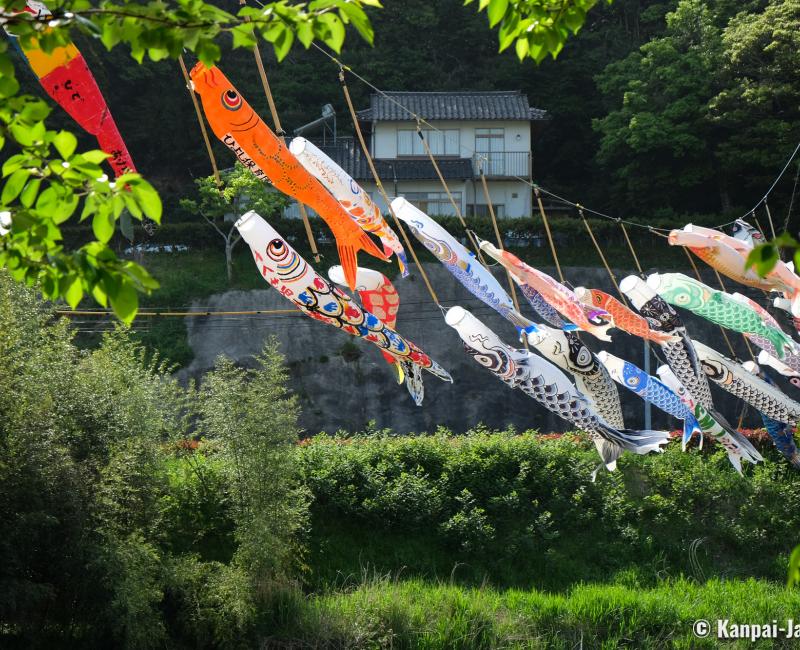
Introduction of koi nobori during Edo period
The koi nobori (鯉のぼり) is a pole on which one to several flag carps are attached. Its use developed in the merchants and artisans classes of Edo period and mainly in Edo (former Tokyo) and in Kanto area. The symbolic of the carp is quite powerful: this fish can as easily live in clear waters than in in ponds or marshes' muddy ones. Moreover, its ability to upstream swimming made its reputation of a perseverant being with a lot of vitality.
This fish is also a reference to a Chinese legend in which a carp became a dragon and flew to the sky as it swam upstream the waterfall Ryumon (竜門 "gate of the dragon"). The story gave birth to the expression toryumon (登竜門), the "gate to the success."
The carp symbolizes the wish for the child’s success, regardless of his environment and of the circumstances.
How to celebrate Kodomo no hi?
Kodomo no hi, or tango no sekku, is celebrated on May 5, but the feast often begins on the day before. It is a family gathering favored by the succession of holidays during the Golden Week. As in all traditional celebrations, Kodomo no hi has its specialty dishes to enjoy with family and friends:
- Dishes made with carp and chestnuts,
- Chimaki (粽), a salted glutinous rice cake, often wrapped in a bamboo leaf,
- Kashiwa mochi (柏もち), a glutinous rice pastry filled with red sweet been paste and wrapped in a sweet oak (Kashiwa) leaf.
The habit of eating kashiwa mochi is specific to Japan. The pastry’s name derives from the sweet oak, a tree that does not lose its older leaves before new buds have appeared. It symbolizes the continuity between generations.
Continuation of ancient rituals
Tango no sekku is also inseparable from the sweet flag, or shobu (菖蒲) herbs renowned for repelling evil spirits. This plant is used in many ways for the occasion:
- Brewed in sake (shobuzake 菖蒲酒), a drink to prevent diseases,
- Placed on the houses’ roof or eaves to protect its inhabitants,
- Shaped as pillow (shobumakura 菖蒲枕 ) to protect sleep,
- Immersed in the bath’s water (shobuyu 菖蒲湯), to prevent diseases.
And naturally, the house is decorated with the celebration’s regalia: koinobori 🎏 outside, and samurai armor and helmet inside.
The first Kodomo no hi
A boy’s first tango no sekku is the most important and is celebrated while he is still a baby. The ritual hatsu sekku (初節句) (first sekku), has been practiced since Edo period to ensure a strong and healthy growth to the child.
Traditionally, a warrior doll and / or a samurai helmet is offered, mostly by grandparents on the mother’s side. Nowadays however, both families can share the expense of the present.
The other members of the family, or close friends, will rather give a Kintaro or Momotaro doll, or a koi nobori.
In some areas, the celebration also consists in kite flying (tako age 凧あげ).
What are the different decorations and their meanings?
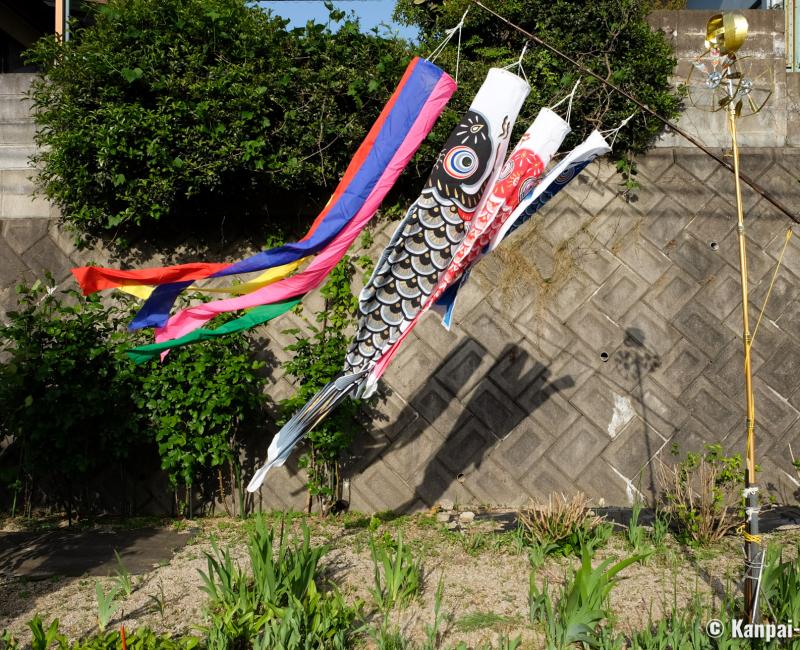
Koinobori
Also called satsuki nobori (皐幟) or koi no fukinagashi (鯉の吹き流し), the koi nobori is a pole placed in the garden near the house, decorated with carp motifs. The shapes can be made from paper or fabric, depending on the period, and flutter in the wind.
The inside of the house is sometimes decorated with kazarikoi (飾り鯉), or ornamental carps.
A typical koi nobori includes, from top to bottom:
- A kaitenkyu (回転球) or kagodama (かご玉), a kind of spherical object placed at the tip of the pole,
- A yaguruma (矢車), a kind of windmill,
- A fukinagashi (吹流し), a wind sock-like element colored in 5 hues (goshiki fukinagashi 五色吹流し). It can also be decorated with lucky motifs: flying dragon, clouds or carps (gara mono fukunafashi 柄物吹流し),
- The large black carp magoi (真鯉), that existed from the early days of the tradition,
- The red and yellow carp higoi (緋鯉), added during Meiji Era, and,
- The small blue carp kogoi (子鯉 or seigoi 青鯉), added in the early 20th century to have the whole set symbolize a family.
The black carp was sometimes decorated with a red-body boy holding the carp firmly, in a reference to Kintaro’s legend.
Before World War II, magoi and higoi carps represented respectively the father and the son. From the 1950-1960’s and the evolution of family structure, the higoi carp started to represent the mother, and the blue carp become the one symbolizing the child. More recently, small kogoi carps of vivid colors have been added to represent all the siblings, girls and boys altogether.
However, the falling birth rates in Japan, combined with the widespread habit to live in residential buildings without garden, tends to undermine the koi nobori custom.
On a side note, the tradition is particularly strong in Kyushu and Shikoku, even if it started more recently there.
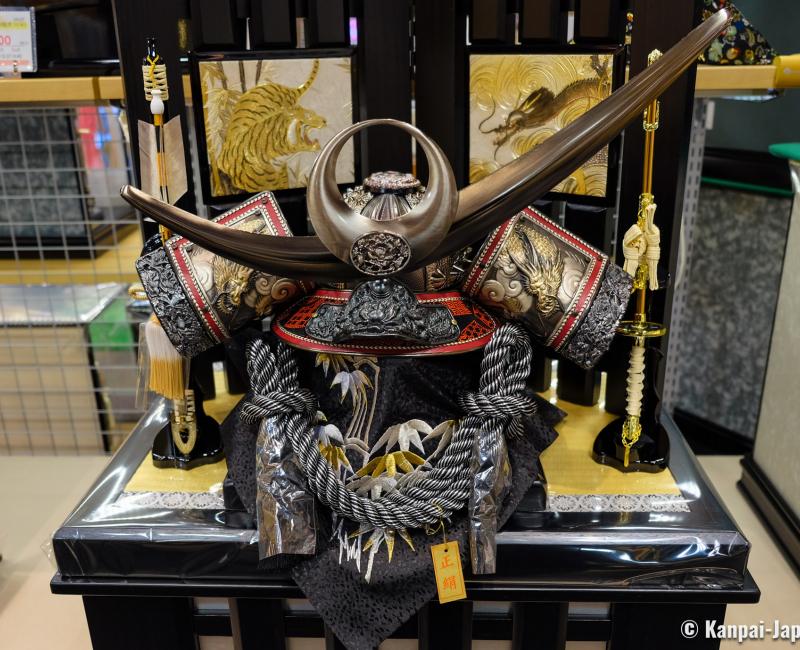
The gogatsu ningyo
A gogatsu ningyo (五月人形, literally "fifth month doll") was originally the doll or the miniature helmet offered to the boy for tango no sekku. Now this term relates to all the objects or decorations displayed for this celebration, including sometimes the koinobori.
Dolls owners take as much care of them as they do for Hina Matsuri 🎎 dolls, and they sometimes display them on a three-step stand, named sandai (三台), that only the wealthiest families can afford.
On the highest step, the items placed are:
- In the center: the samurai helmet (kabuto 兜) and / or the armor (yoroi 鎧). They still have their symbolic role of protection from contemporary dangers, such as traffic accidents. They are supposed to receive the misfortune and luck instead of the child.
- The kabuto sashi (兜差 , "helmet wearing character") can replace or be associated with the former. It is a boy’s doll wearing the helmet and / or donning a general’s attire. These items are offered by the family or relatives for hatsu sekku.
- On the right, a bow and arrows to destroy demons (hamaya 破魔矢), from the legend of Shoki, a Chinese warring deity. In Kamakura period, arrows were offered to a warrior family where a boy was born, as an auspicious ornamentation.
- On the left a sword (tachi 太刀), not for battle but to ward off demons thanks to its brightness, as they fear light. Initially, it was used during rituals before becoming an ornamentation for this celebration.
Usually a gilded screen (byobu 屏風) is placed behind the displayed elements to highlight them, but also for its initial purpose of separating and protecting. It can be adorned with several kinds of motifs:
- Fujin (風神) or Raijin (雷神), respectively the gods of wind and thunder, protectors from evil spirits,
- The dragon to attract luck,
- The tiger for a healthy growth,
- The carp for vitality.
The second step displays three indispensable items for a battle (sanpin 三品):
- Gunsen (軍扇), the war fan to give direction to the army,
- Jingasa (陣笠), the foot soldier’s hat; and,
- Jindaiko (陣太鼓), the war drum to give the signal to the troups.
Lastly, the third step is dedicated to the three treasures (sanbo 三宝):
- Heishi (瓶子), in the center, are sake containers in which shobu stems were planted,
- Kashiwa mochi on the right; and,
- Chimaki on the left.
Families usually settle for the first step, or the kabuto sashi doll, that can be complemented by a banner bearing the name of the boy (namae hata 名前旗) placed on the side.
Ideally, every boy in the family should receive his own gogatsu ningyo, but due to the lack of storing space and their cost, the habit of displaying one banner per boy has developed. In the same way as the other objects, the banner symbolizes the prayer for each boy to grow healthy.
Dolls to foster moral values
Other dolls can be offered for Kodomo no hi. They represent real or legendary characters who are appreciated for their warring abilities and their intelligence. Among the most popular are:
- Ushiwakamaru (牛若丸), Minamoto no Yoshitsune (1159 - 1189)’s youth name, he was renowned for being a genius tactician and a full-fledged warrior. Despite a difficult start in life, he succeeded to raise to the shogun position and founded Kamakura’s bakufu (government). He is pictured as a young boy, with a flute in the hand in reference to his meeting with Benkei.
- Benkei (弁慶, 1155 - 1189) was a very violent warrior monk. He became Yoshitsune’s vassal after he attacked him to steal his weapon. His strength was only equal to his loyalty towards his lord, and the legend has it that his body was still standing after his death. He is pictured carrying a bunch of weapons on his back.
- Momotaro (桃太郎), the legendary boy born from a peach, although a little bit lazy, was renowned for his extraordinary strength. He chased away demons from Onigashima with the help of animal he brought alongside. He symbolizes the ability to repel evil and to unite. He is pictured wearing lavish clothes and bearing a banner stating 日本一 (nippon ichi) "Japan’s best".
- Kintaro (金太郎) was the infant name of Sakata no Kintoki, a half-legendary character who supposedly lived in the early Heian period, and who also served the Minamoto’s. He was raised in the mountains by an ogress, and was blessed with a superhuman strength and an unflinching courage. A famous story tells how, as he was still a child, he captured a carp that was bigger than him. He is pictured as a child with a red body and fighting a carp or dressed in a red apron and wielding an axe.
- Shoki (鍾馗) supposedly lived in China between the 7th and 9th centuries. He studied hard to become a civil servant, an important position at the time, but he was rejected due to his ugliness. He committed suicide in protest, and the emperor, moved by his story, had his funeral held with compassion. Later, as he was severely ill, the emperor dreamt of a big demon chasing a smaller one. It was Shoki, who came to help the emperor and show his gratitude for his consideration. Upon waking up, the monarch, healed, ordered that Shoki was pictured as he appeared to him. His frightening image is used to ward off diseases, but also to ensure academic and professional success for the child and pray for him to be a grateful person.
Lastly, paper-mache tiger (hariko no tora 張子の虎) represents a roaring tiger, whose head is mounted on a longer than nature neck that can oscillate from top to bottom. Since Edo period, it is offered at the fist tango no sekku, mainly in Kansai area. Placed alongside the samurai helmet, it symbolizes the parent’s affection and their will to protect their child in the same way a tiger defends her cubs.
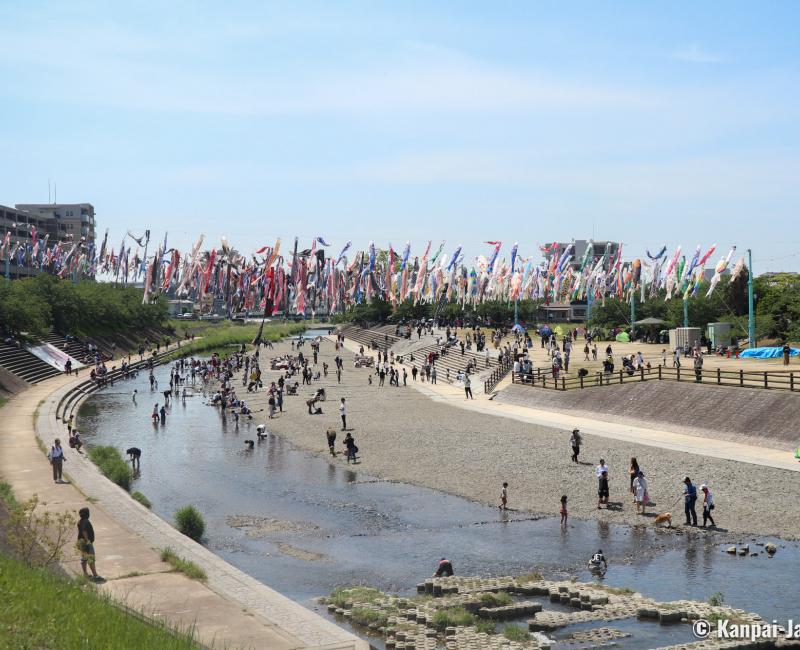
Where to see koinobori in Japan?
Contrary to Hina Matsuri, Kodomo no hi is not characterized by public celebrations. The Children’s day on May 5 is celebrated at home, at small scale. It is however visible throughout Japan in decorated sites where families can gather:
- On river banks: Sumida River in Tokyo, Kamogawa in Kyoto, or Akuta River in Takatsuki in Osaka prefecture,
- In parks: Tokyo Midtown or Tokyo Dome City, among others; and,
- Near some touristic attractions such as Tokyo SkyTree or Tokyo Tower.
While walking around, it is possible to spot flags shaped as carps floating from the houses. Some neighborhood Japanese pastry shops prepare the traditional rice cakes.
Shops for tourists usually sell objects in relation to this time of the year, such as small koinobori hangings to bring back as a souvenir. Very few stores display the traditional gogatsu ningyo in their windows. The best places to see them are hotels 🏨 lobbies, such as in Kyoto for example, or shops specialized in Japanese dolls, throughout the country in April, or in one of the dedicated museums on the rest of the year.

